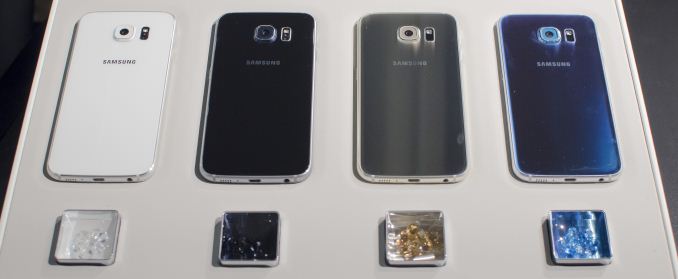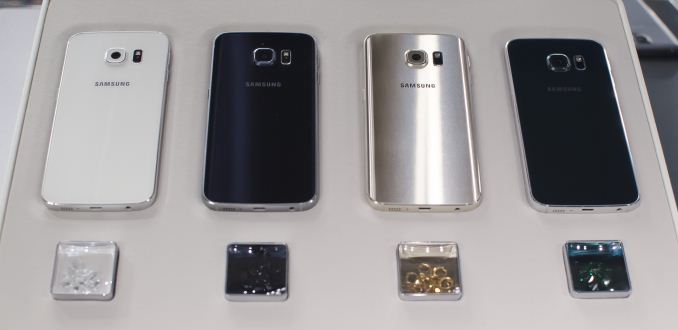Samsung Galaxy S 6 and S 6 Edge: Preview
by Joshua Ho on March 26, 2015 9:00 AM EST- Posted in
- Smartphones
- Samsung
- Mobile
- Galaxy S6
- Galaxy S6 Edge
Initial Thoughts
With the Galaxy S6 and S6 edge Samsung claimed that they wanted to completely rethink how they designed and made smartphones. On the surface, it seems that Samsung has delivered on this promise as the Galaxy S6 and S6 edge are unlikely any other Galaxy S phone they have made previously. There is no removable battery, no microSD slot, or even a removable back cover. I would’ve liked to see a microSD slot, but I personally wouldn’t be affected by being limited to 32GB of internal storage. The removable battery issue is a bit concerning for me though, as it’s likely that disassembling this phone to replace the battery will require extensive use of a heat gun to loosen glue that may not adhere properly when reassembled. The materials are now aluminum and glass, which dramatically affect in-hand feel. I definitely like the move to the aluminum and glass design for the improved look and feel of the phone, but the use of the glass back is a bit annoying as the phones have a tendency to slide off pretty much any table. The edge variant of the phone also feels quite sharp in the hand and almost too thin to hold, but this is generally quite subjective.
Outside of design, there is a lot to talk about in the SoC and display. The Exynos 7420 SoC appears to be class-leading in performance, although there is the obvious question of power consumption that still has to be answered. Samsung’s first 14LPE SoC seems promising, although we’ve yet to validate whether big.LITTLE is more efficient than when we last tested it in the Exynos 5433. The GPU is generally quite close to the Adreno 430, with about a 10-20% advantage in performance depending upon the workload, although at the same clock speed it probably wouldn’t have any advantage. The 1440p display can also reduce performance compared to a 1080p display.
Speaking of displays, Samsung has integrated an incredible display into both versions of the Galaxy S6. I’m really blown away at how far AMOLED has come in the past few years, as the Galaxy S6 is one of the best displays we’ve tested for luminance and overall color accuracy. The only real problems I can see are color shifts with viewing angles, and white point tending to be a bit green depending upon the unit we’re looking at. There are some edge-specific issues, namely uneven luminance and odd color shifting towards green hues on white at the edge of the display. Other than this, the display of the Galaxy S6 is relatively perfect with its dark, inky blacks and amazing color.
Obviously an SoC and display aren’t the only issues to discuss in a smartphone, but given the limited time that we’ve had with the device this was all that could be tested. We hope to have our full review for both devices completed in the near future, and to be able to provide the full picture of the Galaxy S6 line at that time. Pre-orders for the US Galaxy S6 variants will begin on March 27th, and the phone will go on sale on April 10th throughout the US with 32, 64, and 128 GB SKUs in Black Sapphire, White Pearl, and Gold Platinum. The S6 edge and S6 will be available on AT&T, Sprint, T-Mobile, Verizon, and US Cellular, but on Boost Mobile, Cricket Wireless, and MetroPCS only the S6 will be available.













200 Comments
View All Comments
Zizy - Thursday, March 26, 2015 - link
Samsung used to have all that, that's the point :)Similar to Windows RT and ChromeOS for example. Similar stuff, but RT is hated for being limited, while ChromeOS is praised for that.
NEDM64 - Thursday, March 26, 2015 - link
So if the iPhone doesn't have, then it's not needed?That's not how to make a superior product.
Chaser - Thursday, March 26, 2015 - link
The first large sized smartphone was invented a few months ago.hrrmph - Friday, March 27, 2015 - link
Exactly correct.As I have tried to get folks to understand repeatedly: the iPhone always was an upper-middle level offering, never a premium high-end flagship phone.
Samsung made the premium high-end hardware. They provided many of the extra features that Apple refused to support...
... and now Samsung is effectively abandoning the premium high-end flagship market by downgrading their offering to the S6. The S6 is, just like the iPhone, an upper-middle market machine.
So who will inherit Samsung's former position at the top of the premium high-end flagship market? HTC, Huawei, LG, Motorola, Sony? Somebody else?
steven75 - Friday, March 27, 2015 - link
The reason you've "tried to get folks to understand repeatedly" is because no one else believes that nonsense.Lonyo - Thursday, March 26, 2015 - link
Well, for me, I could buy a Galaxy S6 to replace my S3, except I got a 128GB MicroSD card for my S3, so why would I want to have to buy the most expensive S6 in order to get less storage (as the S3 also has built in storage), when I could get a competitor's phone which has a MicroSD slot? Samsung removed an upgrade path for me to their newest phone by removing the MicroSD slot. The result? I ordered a different phone to upgrade to (although I've gone the whole hog with a Lumia 640 to try Windows Phone).Existing Galaxy users may have MicroSD cards like I do, and they would then be rendered mostly useless. iPhone users don't have MicroSD cards, so it makes zero difference to them.
makxon - Friday, March 27, 2015 - link
Right dude you can get a midrange phone with micro SD i'm sure its enough of big upgrade from your S3, now "premium" flagship is not all about bang per buck okay, flagship and "premium" phone is arguably only for show. and i'm sure rich people who buy it is not that stingy to decide their next phone just because they already have 128GB microSD ready to use, lolhrrmph - Friday, March 27, 2015 - link
Premium high-end flagships aren't just for show. Samsung was winning because their hardware did more, even though it was wrapped in plastic. I never had a problem with plastic - the best that I've seen is the Blackberry Z10, but Samsung's was never terrible.What Samsung didn't do here was maintain their superiority. If they had put 128GB storage on the inside, and a Micro-SD slot, then then the phone would hold 328GB of storage (SanDisk now has a 200GB Micro-SD chip to fit in the slot).
Today's Micro-SD slots meet the SDXC standard which means that just like hard drives, they are upgradeable to larger sizes as soon as newer chips are made. SDXC supports up to 2TB, even though 200GB is currently the largest.
For folks who need local storage, Samsung was usually double or more the capacity of the iPhone. For example, Apple can't touch 328GB of storage. But, Samsung let the premium high-end flagship market down by not letting us have 328GB of storage.
steven75 - Friday, March 27, 2015 - link
Samsungs sales took a dive and they panicked. Have you not been paying attention?danbob999 - Thursday, March 26, 2015 - link
"This level of progress is amazing from Samsung, given just how bad things were with the Galaxy S' AMOLED display"Am I the only one to find it ironic that the Galaxy S display was considered one of the best by this web site?
"I’d say Samsung’s Super AMOLED is in the running for best display on a smartphone up there with the iPhone 4’s Retina Display. Apple has the resolution advantage, but Samsung has a huge contrast advantage. The former is nicer for reading text, while the latter is better for just about everything else."
http://www.anandtech.com/show/3891/samsung-epic-4g...